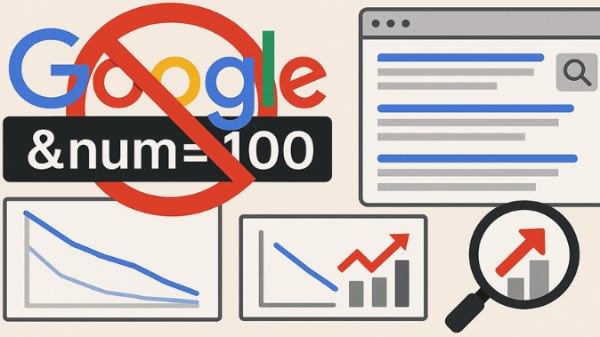Introduction
It began quietly, as most major digital shifts do. One day in late September 2025, marketers noticed that their favourite Google trick no longer worked. For years, experts could tack “&num=100” onto a search link and instantly see one hundred results instead of ten. It was an open secret among SEO (Search Engine Optimisation) professionals - a small line of code that unlocked a panoramic view of the web.
Then, without warning, Google closed that door. What looked like a technical tweak has instead sent ripples through the marketing industry, confused data teams and sparked debate about how much of the internet’s machinery we’re still allowed to see.
The Hidden Shortcut That Powered an Industry
That small “num=100” command was more than a convenience; it was the backbone of how many digital tools understood search behaviour. By loading a hundred listings in one go, ranking trackers could measure visibility across an entire field of competitors in seconds.
Imagine a researcher who once viewed a city skyline from a tower now being told to walk the streets to count every building. The picture becomes narrower, slower and, crucially, dependent on what Google decides to show.
To Google, the adjustment makes sense. Automated scraping - when bots repeatedly collect large amounts of search data - puts strain on its systems and risks exposing how its results are ranked. Limiting access helps protect both performance and privacy.
It also makes Google’s reporting more realistic. Few people ever click beyond the first few pages of results, so showing one hundred at once paints an artificial picture of what users actually see. By tightening the flow, Google ensures that its impression data, which measures how often a website appears, better reflects real human activity rather than automated noise.
The Business Case
Behind this technical tweak lies a strategic play. Google’s true product has always been information - how it’s sorted, displayed and monetised. Every insight pulled from its results is a small piece of that product. By limiting external access, Google strengthens its control over a resource that fuels both its advertising empire and its competitive advantage.
SEO and analytics companies built their businesses on interpreting Google’s search patterns. Now, with one key tool removed, they must adapt or fall behind. The change pushes marketers toward Google’s own services, such as Search Console and Ads Manager, which conveniently offer official - and carefully filtered - data.
From a commercial standpoint, the move is efficient. It discourages unauthorised data extraction, reduces technical costs, and consolidates customer reliance on Google’s own ecosystem. In an era when every tech giant is tightening its grip on proprietary data, the world’s biggest search engine is simply reinforcing its fortress walls.
Legal Team Involvement
A shift like this would not happen without careful consideration from Google’s internal legal departments.
- Competition Lawyers assess whether reducing data access could attract regulatory attention for stifling smaller analytics firms or AI startups.
- Commercial Lawyers review existing agreements with data partners to ensure compliance with the new restrictions.
- Privacy and Compliance Lawyers confirm that the reduction aligns with user protection and responsible data handling principles.
- Intellectual Property Lawyers defend Google’s right to protect its algorithms and search methodology from external replication.
Each department plays a role in framing the change, not as a wall but as a safeguard - a defence against misuse, rather than a restriction on transparency.
Future Outlook
What appears to be a minor technical update may signal a turning point in the history of the open web. As AI-driven search tools such as ChatGPT, Perplexity and Anthropic’s Claude rise in popularity, access to raw search data has become more valuable than ever. These systems rely on understanding how information is ranked and retrieved. The less data they can see, the more dependent they become on the companies controlling it.
This is the broader story behind Google’s quiet switch: the web is no longer an open library but a series of guarded collections, each curated by its own gatekeeper. If AI tools cannot study the whole landscape of search, their understanding of the world becomes narrower, shaped less by the web itself and more by those who own its keys.
For everyday users, nothing has changed. The search bar still works; the answers still appear. But for marketers, developers and AI researchers, the world’s biggest window into online knowledge just became a little smaller. In the long run, this might not just redefine how we search - it could redefine who controls the story of the internet itself.
